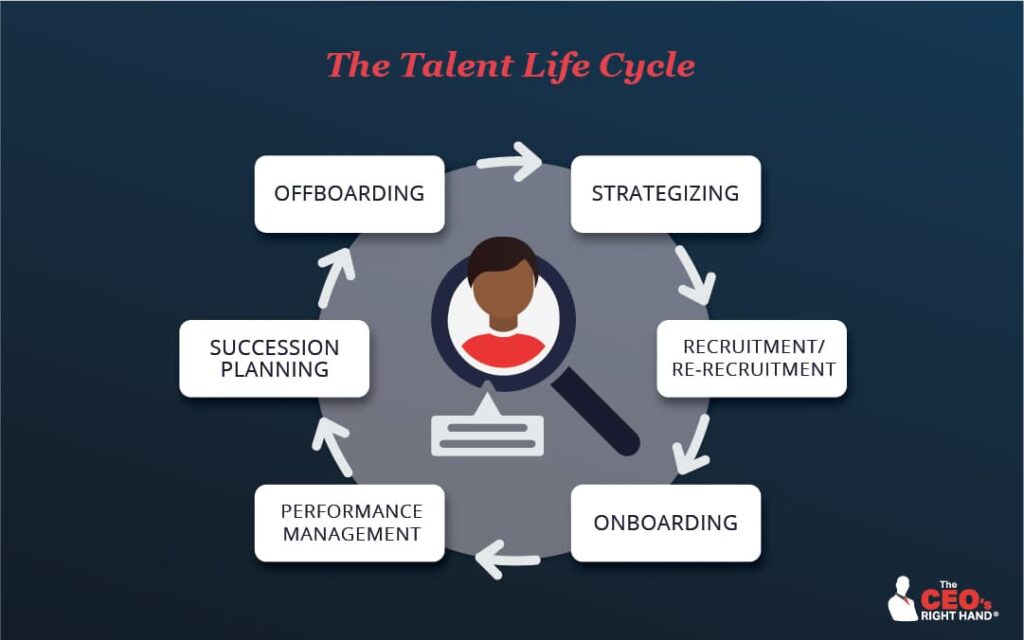
Every successful business leader understands (conceptually) that people are the backbone of a company. But it is one thing to acknowledge that reality and quite another to prioritize investment in your talent life cycle. After all, if you have a great product or service and offer competitive compensation, isn’t that enough?
In short, that is not enough because people are complex, and your relationship goes well beyond the duration of their employment. Therefore, to truly build a thriving organization that can grow and scale, you must master the talent life cycle. So, in this post, I will explain the talent life cycle, why it matters, and the various stages.
What is a Talent Life Cycle?
The term “talent life cycle” refers to the entire process of building an energized, effective, and satisfied workforce that will fuel healthy business growth. It involves the development of strategies to attract the right people and support their success. Doing so encourages performance, bolsters your employer brand (thru employee advocacy), and makes hiring easier. As such, the talent management life cycle spans your entire relationship with potential and current employees from well before they join until long after they leave.
In the early stages of a company’s growth, business leaders often hire people they directly know or from their networks, and this can work for a while, especially when you are a start-up and need fewer hands to do the work. However, when you reach a point in your company’s evolution where you are ready to scale, you must become more strategic.
What Are the Benefits of Strategic Talent Life Cycle Management?
The people you hire to represent and run your business can make or break your company. So, it is in your best interest to treat employees like a precious resource and develop a framework for attracting, managing, and empowering them to thrive.
However, in my interactions with business leaders, I have noticed that many get so excited about the company’s work that they forget about the people. As someone in a leadership role, you don’t have that luxury. As a people leader, you must focus on talent management, which requires a different skill set. So, we develop those skills as part of this process.
Therefore, when you apply a strategic approach to talent life cycle management, you realize benefits that will forward the work of your company, such as:
- People management skills.
- The ability to attract and retain top talent without breaking your budget.
- An improved company reputation.
- The development of efficiencies.
- A reduction in costs (through efficiencies and employee retention).
- The acquisition of critical resources for managing and stimulating growth.
What Are the Talent Life Cycle Stages?

Strategic talent life cycle management is about establishing supportive processes, policies, and mechanisms for the people. So, you must always consider the employee experience – how each person might use and interpret the messages and tools you put in place. For example, as leaders, we know it is imperative to set expectations, but it is equally important to keep them reasonable and to adhere to them. Setting expectations but failing to hold people accountable (including yourself) is worse than not setting them at all.
With that in mind, let’s explore the six stages of the talent life cycle.
1. Strategizing
For the first stage of the talent life cycle, we aim to develop a holistic view of your company as an employer. We look at your:
Human Resource Infrastructure 360°™
Don’t let costly human resource issues creep up on you. Learn about the 5 components of HR Infrastructure 360°™ - our proprietary framework for building and supporting your team.
- Reputation in the employment marketplace.
- Current systems, practices, and people.
- Competency requirements.
- Organizational culture.
To clarify, when I say organizational “culture,” I mean the beliefs, values, and norms considered acceptable at your company and how they influence how you behave with candidates, employees, clients, and partners. Exploring your workplace culture and existing mechanisms helps us understand what it takes to fit into your environment and succeed at your company. It also helps us see the roadblocks and how we can optimize your current workforce while developing a talent pipeline.
For example, we analyze your employer brand and reputation by examining review sites like Glassdoor and Fairygodboss to gain insight into the strengths and weaknesses of your Employee Value Proposition (EVP). We also look at your reward and compensation practices compared to the overall market and speak with employees to understand their skill sets, how they feel they can best contribute, and their experience with your company thus far. That gives us an understanding of the resources and skills you already possess and illuminates the gaps.
Then we compare what we discover to your vision for the future so we can develop a go-forward action plan for strategic human resource management.
2. Recruitment and Re-recruitment
During the next stage of the talent life cycle, we assess and refine your recruitment and re-recruitment process. That includes every step of the hiring process, including:
- Identifying the skills and characteristics that make a candidate a good match for your organization and each role, including any criteria that would help you reach a bigger talent pool. For instance, do you need employees on-site during regular business hours, or can you provide a flexible arrangement?
- The messaging you share in your job descriptions and on social media about what it means to be an employee at your company. That is part of your value proposition as an employer, which helps candidates determine whether you might be right for them.
- Your system for tracking and communicating with hiring managers and candidates during talent acquisition.
- The talent sourcing strategies used for finding and attracting applicants (which ideally will include reaching out to former employees).
- How you conduct interviews.
- Your system for developing offers and navigating negotiations.
A well-organized recruitment process will create internal efficiencies. But, just as importantly, it sends a clear message to candidates about what it might be like to work with your company so that they can factor that insight into their decision-making.
For instance, when I manage an HR department, I insist on clear, timely, consistent, and transparent communication with everyone involved, including the candidate. Exploring a new role requires a significant investment of time and energy, so I want to ensure that every applicant feels respected throughout the process.

I also prefer that leaders interview each candidate and honestly explain what to expect if they join the team and company. Be straight with them about working hours, level of work, and difficulties with process, and look for candidates with grit who will love the challenge and appreciate your honesty. I would rather the candidate gracefully decline than join the organization only to leave in three months due to misaligned expectations. Each time this happens, your brand and reputation take a hit.
3. Onboarding
Once an employee says yes, we move to the next stage. Like the recruitment process, your onboarding proceedings are vital. Ideally, you will have a plan for supporting each employee so they can hit the ground running and achieve some level of success within the first 90 days. That will help them assimilate into the company culture, team, and role until they feel they are part of the organization.
Naturally, there will be paperwork to sign and a process to establish payroll, benefits, and any required equipment or systems access. And you might even establish a training program to get them up to speed. But I would argue that you need to take it a step further and carefully consider the workplace environment and how to ensure they can thrive.
For example, what building blocks do you have to get this person up and running if they work from the office, and how does that change if they work remotely? What do you expect your leaders to do to clarify expectations and help them succeed? It is costly to recruit, hire, and train new employees. So, thinking through everything that needs to happen to get new hires off to a good start is critical for minimizing attrition.
4. Performance Management
You might think that once an employee settles in, you can relax somewhat. And that is true to a certain extent, but now the focus shifts to a management approach designed to keep the employee engaged, motivated, and empowered long after the honeymoon phase so they can grow and scale with your organization. So, what does this look like in practice?
Regular Check-Ins
Every employee, even those at the top of their game, needs a manager who will provide coaching at regular meetings. These meetings offer the opportunity to set individualized goals and objectives for the position and the employee’s career. The manager should also provide direction, discuss the employee’s progress, and confirm they have what they need to succeed.
One-on-one meetings are also a great time to check in on your employees’ well-being, ensuring they feel safe and supported. People will inevitably experience challenges, so if they have a problem with the environment, a co-worker, or something at home that could affect their performance, you want them to feel comfortable sharing it with you. That will enable you to adjust expectations and provide the support they require to get back on track.
Periodic Surveys
Developing a practice of surveying your employees allows you to continually gather insights into the employee experience. So be sure to create a year-round feedback loop to identify and address issues and increase performance while avoiding surprises.
A Formal Annual Review Process
In addition to regular check-ins, you need a formal annual review process, which will require more planning and structure. Each year you should come prepared to give the employee an overall sense of how they are doing and to discuss any changes in how you (or others in the organization) see their role, career within your company, or expectations. You must also reassess their compensation to ensure it is competitive, equitable, and keeping pace with inflation.
5. Succession Planning

Although some consider succession planning part of performance management, I worry that makes it easy to overlook, so I like to call it out separately in the talent life cycle. Succession planning gives leaders the tools to support employees throughout their careers. It empowers you to build, nurture, and retain an engaged and happy workforce in two ways.
First, it gives employees visibility into their future at your company. Through the development of career ladders, individual development plans (IDPs), and succession planning, you create engaging challenges and opportunities within each role while offering resources (such as leadership development training and tuition reimbursement) to help employees move forward.
Succession planning also helps the company understand what makes certain employees successful at their jobs and what holds them back so it can replicate the hiring process. For example, does a particular mix of experiences, education, competencies, or communication styles work well within your environment? Such clarity emboldens you to develop top performers into leaders who can move up within your organization (vs. feeling stuck), filling critical roles and becoming coaches and mentors to the next class of recruits.
That is how you grow and scale a company from an employee perspective. When you hire wisely and develop processes and procedures that allow you to nurture employees, they stick around, strengthening your organization with their growing experience. And, almost as a byproduct, you will spend less time (and money) hiring and training new employees.
6. Offboarding
Of course, not every employee will stay with your organization. Occasionally, circumstances at your company will change (resulting in layoffs), someone will be a bad fit, or an employee will reach a point in their career (or life) where they need to move on.
That is normal and expected. It’s how you deal with it that matters. In other words, the end of an employment relationship is never really the “end.” It is simply a change whereby (if you handle it gracefully) that person becomes part of your network, a source of referrals, and can help build your brand and the next class of employees.
So, once again, the trick is to consider the situation from the employee’s perspective, then strive to end the relationship positively. If they are leaving, try to understand what happened and if either party could have done something different. And if you wish to end the relationship, ask yourself how you can do so respectfully and what kind of support you can provide to help your employee move toward the next chapter of their life.
Mastering the Talent Life Cycle
Talent life cycle management is critical for companies of all sizes. The stages above represent the holistic view, but I recommend an iterative, data-driven approach for continuous improvement. A seasoned HR executive can assess where things stand today, develop a long-term vision for the future, then identify and prioritize the necessary improvements.
But don’t worry if you do not need (or cannot afford) full-time strategic human resources leadership. At The CEO’s Right Hand, we offer C-level fractional human resource services for small and medium-sized growth companies. Reach out today to learn more.





